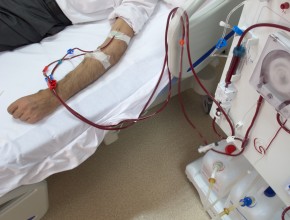Standardized perioperative management of patients with AF receiving DOACs
A standardized approach to the management of patients with atrial fibrillation (AF) receiving direct oral anticoagulants (DOACs) and undergoing surgical procedures is associated with a low risk of bleeding and thrombotic complications.
In this cohort study over 3000 patients with AF receiving dabigatran, rivaroxaban, or apixaban were managed according to a standardized protocol based on the type of drug, renal function, and type of surgery (low vs high risk of bleeding, with all procedures involving neuraxial anesthesia classified as high risk; see Perioperative DOAC Management). The hypothesis of the study was that safe management would be associated with a major bleeding risk <2% and a thromboembolic risk <1.5%. Generally, DOACs were not given on the day of the procedure and were omitted 1 day before and 1 day after low-bleeding-risk procedures and 2 days before and 2 days after high-bleeding-risk procedures. Heparin-based bridging anticoagulation was not used.
The 30-day postoperative bleeding risk varied from 0.9% (95% CI, 0-1.73) in the dabigatran cohort through 1.35% (95% CI, 0-2.0) in the apixaban cohort to 1.85% (95% CI, 0-2.65) in the rivaroxaban cohort. The risk of a thromboembolic event was between 0.16% (95% CI, 0-0.48) in the apixaban cohort, 0.37% (95% CI, 0-0.82) in the rivaroxaban cohort, and 0.6% (95% CI, 0-1.33) in the dabigatran cohort. The differences between individual DOACs were not statistically significant, although there was considerable imprecision.
In patients undergoing high-bleeding-risk procedures, the rates of major bleeding were from 1% to 3%, even though only a minimal or no residual anticoagulant effect at surgery was observed in 98.8% of such patients; minimal effect (residual anticoagulant levels, 30-49 ng/mL) was reported in 14.0% of patients treated with rivaroxaban, 4.8% of those treated with apixaban, and 0.6% of those receiving dabigatran.
The authors conclude that their simple protocol without heparin bridging was associated with low and acceptable rates of bleeding and thromboembolic events.
Pantoprazole, rivaroxaban, ASA, and prevention of gastroduodenal events
Among patients at high risk of cardiovascular events, treated with low-dose rivaroxaban 2.5 mg bid plus 100 mg of acetylsalicylic acid (ASA) once daily, oral rivaroxaban 5 mg bid, or aspirin alone, the prophylactic use of the proton pump inhibitor (PPI) pantoprazole was of little and uncertain benefit in preventing gastroduodenal events.
This analysis was part of the COMPASS (Cardiovascular Outcomes for People Using Anticoagulant Strategies) study, in which patients participating in a trial of antithrombotic and/or antiplatelet therapy also received oral pantoprazole 40 mg once daily or corresponding placebo. Patients judged to be at high risk of bleeding from any site were excluded, but those with a history of peptic ulcer disease or use of nonsteroidal anti-inflammatory drugs were included in the analysis.
During a mean follow-up of about 3 years the primary outcome, significant upper gastrointestinal (GI) events, was rare (0.6% per year) and occurred in 102 out of 8791 patients in the pantoprazole group and in 116 of those randomized to placebo (1.2% vs 1.3%; hazard ratio [HR], 0.88; 95% CI, 0.67-1.15). This primary event included overt upper GI bleeding, occult bleeding with a hemoglobin drop of at least 20 g/L, symptomatic gastroduodenal ulcer or erosions confirmed by endoscopy, upper GI obstruction, or perforation. Among all components of the primary event, the frequency of gastroduodenal bleeding confirmed by endoscopy decreased by half (HR, 0.52; 95% CI, 0.28-0.94), which reflected 16 versus 31 events and translated into a number needed to treat (NNT) of 1770 per year. If a less stringent definition was used (no need for active bleeding seen on endoscopy), the frequency of gastroduodenal events remained reduced by about half but with a higher absolute impact (NNT per year, 498; 95% CI, 348-876).
The authors attempted to identify patients with a higher probability of benefit (ie, at higher risk of bleeding), but the events were very rare and the effect in individual subgroups was uncertain; it was postulated, however, that the benefit may be higher among patients at the highest risk (eg, those with previous peptic ulcer disease).
Finally, the authors caution that their results may apply to a population at low risk of gastroduodenal complications (eg, most patients had been receiving long-term ASA therapy before enrollment into the study) and conclude that routine use of PPI prophylaxis is not warranted in such groups.
Effects of tranexamic acid on TBI-related mortality
If given within 3 hours of acute traumatic brain injury (TBI), tranexamic acid decreases the probability of head injury–related death, especially in people with mild to moderate injury.
This study included over 12,700 patients with TBI and either a Glasgow Coma Scale (GCS) score <13 or any intracranial bleeding on computed tomography (CT). The effects were examined depending on the time of drug delivery (within 3 hours or later), severity of head injury (severe injury defined as a GCS of 3-8; moderate to mild injury, a GCS of 9-15), and age. Tranexamic acid was given at a dose of 1 g over 10 minutes with subsequent 1 g infused over 8 hours.
Among patients with mild to moderate head injury treated within 3 hours of injury, there was a reduction in mortality (relative risk [RR], 0.78; 95% CI, 0.64-0.95), while in patients with severe head injury tranexamic acid had no effect on mortality. There were no differences in the probability of vascular occlusive events, including strokes, between the tranexamic acid and placebo groups. The degree of disability among survivors was also similar in both groups.
The authors conclude that tranexamic acid should be given as soon as possible after TBI.
 English
English
 Español
Español
 українська
українська







